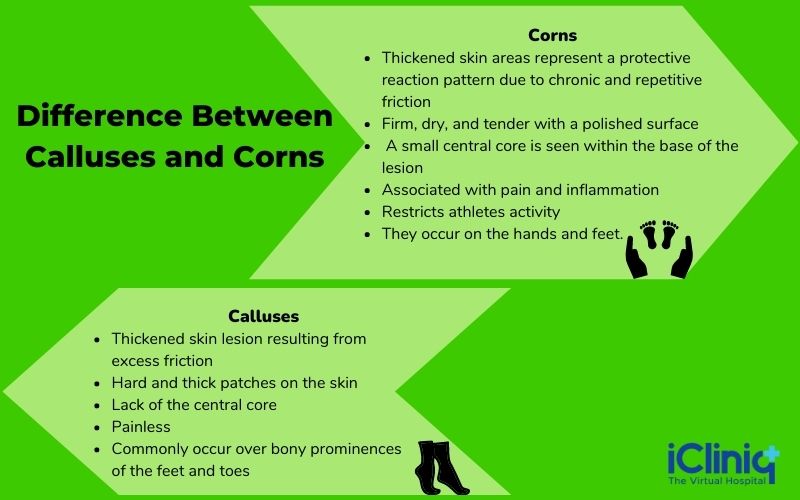Introduction:
Sports dermatology deals with dermatoses in athletes and is a budding field in dermatology. Athletic skin problems are infectious due to close-contact physical activity. Other skin conditions worsen with recurring traumatic injury or exposure to environmental hazards. Dermatologists play a vital role in diagnosing and treating athletes and also prevent the spread of infection to other teammates.
What Are the Cutaneous Manifestations in Athletes?
-
Traumatic and environmental skin injuries.
- Inflammatory conditions.
-
Exacerbation of preexisting dermatoses.
What Are the Traumatic and Environmental Skin Injuries?
Friction Blisters: In athletes, multiple frictional forces cause friction blisters. Rubbing against the skin repeatedly disturbs the skin and results in erythema followed by pallor. It is associated with stinging, burning, and pain that leads to vesicle (elevated, superficial, clear fluid-filled lesions) formation. Blisters most commonly occur in marathon runners.
Causes: Factors that cause friction blister are:
-
Heat.
-
Moisture.
-
Poorly fitting shoes.
-
Excessive training exercises.
How Do Blisters Form?
A hot, humid environment inside the athlete's shoe causes increased sweating and dehydration, which disturbs the protective skin barrier. These factors lead to skin softening and increase the chances of blister formation. The most common sites of occurrence are the tips of the toe, balls of the feet, and the back heel.
Preventive Measures:
-
Wear highly absorbent shocks.
-
Use drying powders.
-
Apply petroleum jelly.
-
Wear properly fitting shoes.
Treatment:
-
Leaving it as an open wound with a mild antiseptic application is enough.
-
Rarely are antibiotics ointments needed to dress the wound.
-
Once the pain has resolved, the athlete can perform their routine activity.
Calluses and Corns:

Treatment:
-
Lesions were palpated for underlying blood vessels.
-
Good foot hygiene.
-
Warm water soaks.
-
Topical application of Retinoids and Corticosteroids.
Knuckle Pads and Athletes’ Nodules:

Treatment:
-
Eliminating the cause of mechanical trauma.
-
Wearing protective gloves.
-
Changing the occupation.
-
Surgical intervention is required when there is a functional problem.
Piezogenic Papules: They are multiple, small, skin or yellow-colored painless papules (solid, elevated, superficial, palpable lesions) found in weight-bearing areas such as the lateral and medial surface of the heel. They are due to prolonged standing or exercise. There is no specific treatment.
Black Heel and Black Palm: The black heel is a self-limited, asymptomatic, trauma-induced lesion- darkening of the posterior aspect of the heel. They are seen in basketball, football, and tennis players. They occur in adolescents and young adults. The black palm is similar to that of a black heel and is seen in weightlifters, tennis players, and mountain climbers. Black heels and black palms are harmless and heal with time.
Erythema Ab Igne: It is a condition that results from chronic exposure to a heat source. They are persistent, lacy-like, erythematous patches associated with hyperpigmentation. They occur due to heat pads, hot water bottles, hot showers, hot stone massages, and steam rooms to relieve muscle and joint pains. Treatment includes referral to a dermatologist. In chronic cases, laser therapy is required. In some cases, malignant transformation is possible.
What Are the Inflammatory Conditions?
Contact Dermatitis: This is an inflammatory reaction of the skin due to direct exposure to the affected person. Continuous exposure to heat, trauma, and moisture precipitates dermatitis conditions.
Clinical Features: Erythematous and pruritic plaques (solid, elevated, superficial, palpable lesions) associated with fluid-filled vesicles (elevated, superficial, clear fluid-filled lesions) or bullae and edema. The skin lesions are sharply demarcated and located in the contact or exposed area. Chronic lesions appear as papules (solid, elevated, superficial, palpable lesions) with crusting.
Diagnosis: Diagnosis can be made from the patient's history and clinical findings. A patch test is also useful for identifying the allergen.
Treatment:
-
Topical soak with cool tap water and silver nitrate solution.
-
Use of topical or oral Corticosteroids.
-
Use of antibiotics in case of secondary infections.
Sunburn and Sun-Related Conditions: Acute sunburn and premalignant skin changes are due to excessive sun exposure. These can be prevented by awareness among the people. But educating athletes is critical as they participate in sports.
Clinical Features: Pain and irritation of the affected area.
Treatment: Use topical sunscreen lotions.
What Are the Exacerbation of Pre-existing Dermatoses?
Acne Mechanica: Also known as sports-induced acne, is papulopustular eruption (solid, elevated, superficial, palpable lesions with pus discharge). It is caused by a combination of pressure, occlusion, friction, and heat. It occurs in the chin, jawline, forehead, neck, and shoulders. Common in football and hockey players, wrestlers, and boxers. Treatment is prevention, such as wearing clean absorbent cotton shirts.
Cholinergic Urticaria and Exercise-Induced Anaphylaxis: It occurs due to sweating as a result of elevated body temperature in athletes. It is a well-defined edematous and erythematous plaques (solid, elevated, superficial, palpable lesions) that resolve within hours. Clinical features are itching, burning, tingling, warmth, and irritation. Lesions usually resolve after eliminating the causative factor. Treatment includes rapid cooling and the use of systemic antihistamines. Individuals with cholinergic urticaria should avoid exercise, hot food, hot bath, and emotional stress as it causes sweating.
Physical Intertrigo: It is an inflammatory condition of skin folds caused by friction from skin-to-skin rubbing. It is usually worsened by secondary infection. Usually occurs in the groin, axillae, abdominal folds, and web spaces of fingers and toes. Symptoms include itching, burning, and stinging. Treatment includes eliminating the causative agent and keeping the skin folds cool and dry.
Conclusion:
Sports dermatology is a budding field in identifying sports-related skin conditions. Repetitive physical activity and exposure to environmental stressors put athletes at high risk of dermatological diseases. Failure to acknowledge the role of sports in pathogenesis of skin diseases can lead to delayed diagnosis and incorrect treatment plan.












